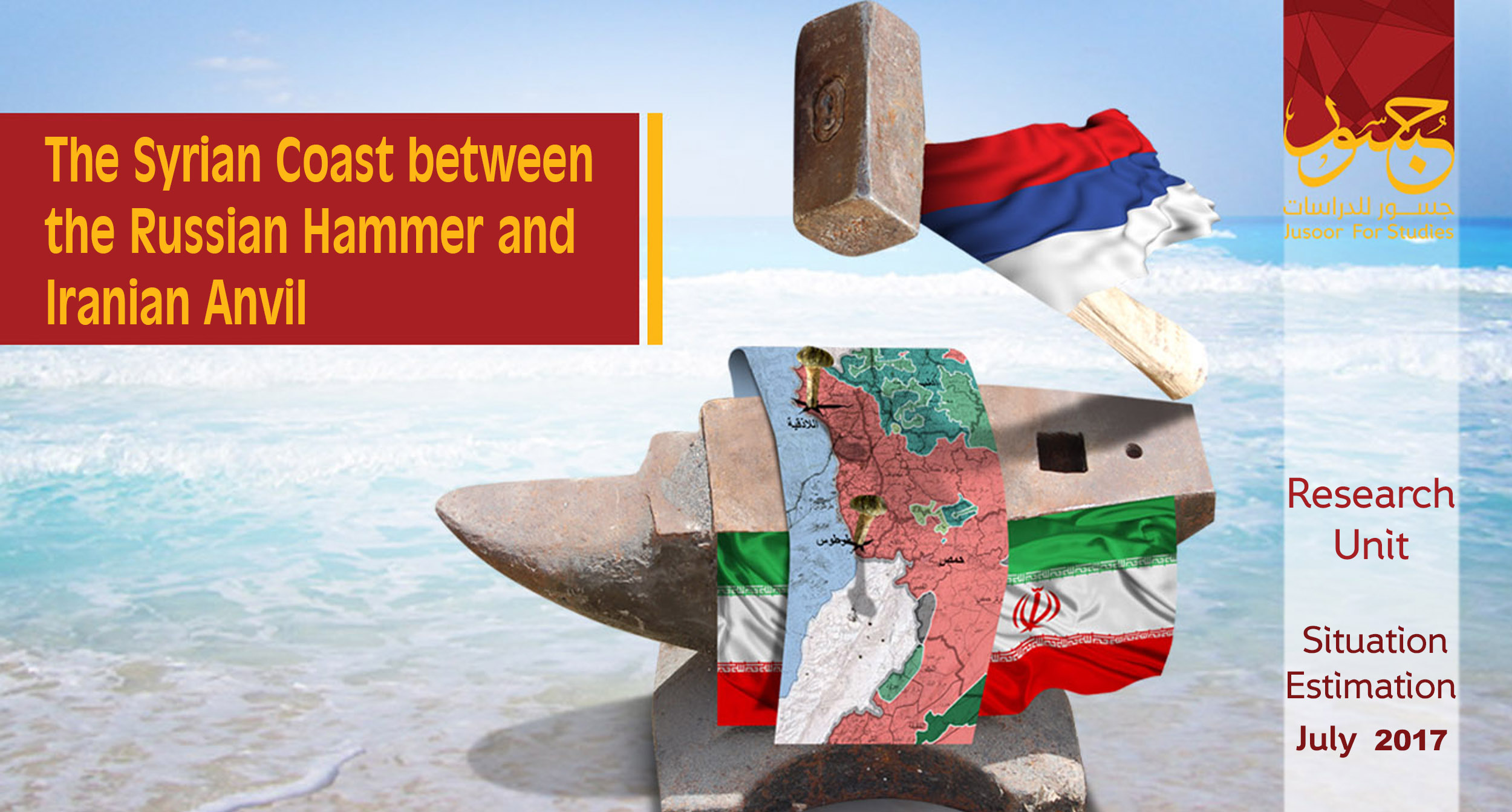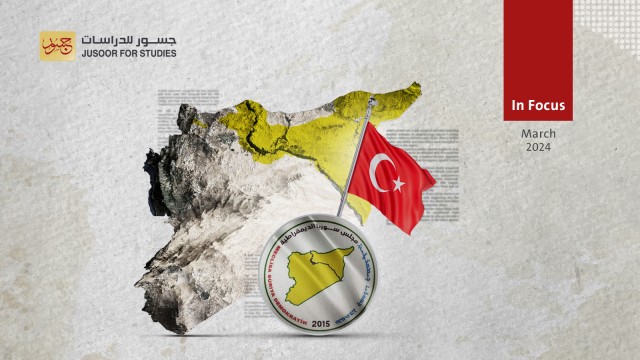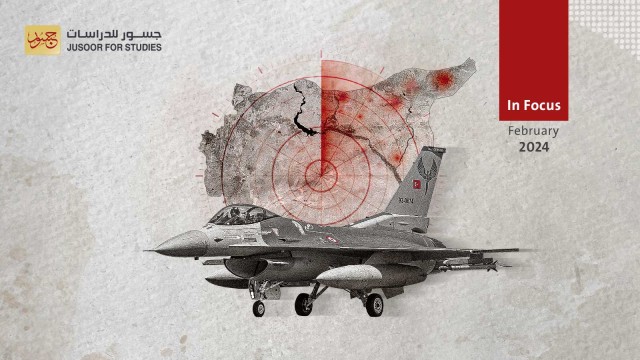The Syrian Coast between the Russian Hammer and Iranian Anvil
Font Size
Preface
Since 2011 till now, The Syrian decision-making moved gradually from Damascus to Syrian regime allies' officers, after Iranian and Russian declared-intervention, analyses and political researches about decision sovereignty in Damascus were varying, as the sovereignty moved to international and regional decision-making posts.
Some events of the past years formed significant models for the type of relationships between the Syrian regime, Iran and Russia. The meeting between Bashar Al-Assad and the Russian Defense Minister was one of the most significant examples, as Russian medias deliberately broadcast this meeting in audio and image, showing the Syrian president surprise because he didn't know about the minister visit, which conveyed a situation of disconnect between Al-Assad and the country that he supposed to rule or even the parts controlled by his forces!
On 20/10/2015, a visit from Bashar Al-Assad (with no delegation) to Moscow took place. During the meeting with the Russian president, all presidential protocols were withdrawn from the Syrian president.
The absence of this sovereignty, formed an implication on the reality ground, at which, Syrian regime lost the control upon the life aspects of its areas, unable to prevent its backers from mobilizing politically and military wherever they wished.
The Syrian coast (under full regime control until now) is an example to be studied. Iranians and Russians were interested in this area (the center of regime's supporters) due to its geopolitical significance along with the economic and demographic considerations.
It is certain that, the Syrian coast is under full control of Russians and Iranians with varying reactions from the locals. This report will address the beginning of foreign influence from Syrian coast locals' perspective, as we will approach some inquiries about the locals' position (since 2011 till now) toward Iranian and Russian influence.
First: Iranian Influence
1. Aspects of Iranian Influence in The Syrian Coast
A. Civil / Industrial Activity
Before 2011, Iranian activities were marked by their civil, religious and economic nature, as Al Murtada Foundation was activating in 1980s under supervision of Jamil Al-Assad in 1981.
Bashar Al-Assad presidency was distinguished by the emergence of Iranian activity through applying for: industry bids, civil (power plants) bids, military (Defense Factories or Scientific Researches facilities) bids, Iranian vehicles (Sapa) marketing bids.
B. Religious Activity
Iran was practicing wide religious activity in the Syrian coast, trying to spread Shiism among Alawites through humanitarian aids and scholarships.
The most notable tools for these religious activities were:
1. AL Rassoul Alaazam University
The university's building is located in Mashrou Shretih neighborhood in Lattakia, opened in 2006 with three branches: Arabic Literature – Legal Studies – Sharia.
Estimated number of students is 5000, the graduates doesn't have any religious or legal obligations, however, the university provides job opportunities to those who acknowledge their commitments toward Wilayat El Faqih ideologies along with being personally from the Twelvers or practice any advocacy activities.
2. Al Rassoul Alaazam Mosque
Located near Al Rassoul Alaazam University as Shiite religious ceremonies are being practiced with incentives and aids to those who attend (an estimation about 1000 newcomers during aids distribution).
Personnel of the abovementioned mosque and university are Iranians with some elements of Hezbollah. There are Iranians who supervise the two places at the same time.
C. Military Activity
Structuring the National Defense Militia with elements trained in Iran early of 2013, played the main Iranian role in the Syrian conflict. The role of this kind of militias was alleviated and replaced by militias with ideological dimension related directly to Tehran.
The establishing of such militia was in conjunction with expanding Air Force Intelligence in addition to raising the profile of Suheil Al-Hassan, an officer in Air Force Intelligence (AFI).
The most notable Iranian militias are:
1. Tiger (Suheil Al-Hassan) Forces
The name of these forces was a clear step of raising the profile of Suheil Al-Hassan after winning battles (started in Hama northern rural), as rumor has it (from his supports and elements) of becoming the next president of Syria after winning the war in Syria under his command.
The Iranian decision formed the password of adopting and expanding the authority of AFI (led by Jamil Al Hasan, who has strong ties with Hezbollah and Iran), turning many small branches and security detachments of 10000 elements into an army with wide powers and more than 100000 elements (enrolling civil elements, military elements and army deserters) distributed in the Syrian provinces, after 2013.
Al Sahhabat Division (led by Ali Mhanna) is affiliated to the tiger's forces with more distinguished and changeable role after the Russians arrival, knowing that, it used to be a normal militia commanded by Suheil Al-Hassan forces, which participated in Aleppo and Homs battles.
2. The National Defense Militia
Established in 2013, most of its elements were in Iran for training of weapons' usage and indoctrination, as Iranian revolutionary leader along with other religious leaderships were religiously lecturing these elements in addition to obliging them to do prayers in the Iranian mosques.
The most significant objectives of these militias were to commit sectarian carnage like: Karam el-Zeitoun, Homs and Bayda Massacre, Baniyas in addition to regular acts of rape and stealing campaigns in all opposing governorates in order to get Alawites involved.
The militia is still active until this day with limited roles and figures, however.
3. Suqur Al-Sahara
Established in 2013 after dissolving National Defense militia and enrolling its elements in Suqur Al-Sahra, which is led by Mohammad Jaber (Bashar Al-Assad relative) with the help of Ayman Jaber, the field and operation supervisor. The militia is in charge of protecting oil plants like the ones in Palmyra as Mohammad Jaber is involved in oil commitments. However, Syrian regime obliged the militia to participate in several fronts like the ones in Idlib and Homs.
This militia offers good salaries (about 50000 Syrian Pounds) while National Defense salaries is 25000 Syrian Pounds.
Gangster-like logic is followed by this militia, at which each group within Suqur Al Sahara is led by a person related to Ayman Jaber, fighting under the tiger forces' command or regime army command.
The militia has light and medium weapons in addition to 4x4s and troops carriers from Syrian regime army. The militia elements' number is about 5000 because of the decline in the Syrian coast youth along with deserting the battle from a great deal of Alawites.
4. Al-Bostan Charity Foundation Militia
Established mid of 2011 with Al-Bostan charity foundation (related to Rami Makhlouf, the maternal cousin of President Bashar al-Assad) funding in Jabla. The militia was dissolved after its criminal act in Homs and its elements joined the National Defense militia.
5. Groups of Tartus' Businessmen
Established with the same approach of Al-Bostan Charity Foundation Militia, as most of their elements joined the National Defense militia later, but kept the groups' original names like: Khodr Al Hussein group and Al Rahhal group.
2. Aspects Caused by Iranian Influence in The Syrian Coast
Iran didn't rely on any Syrian official institution since its intervention, removing these institutions and spreading the militias dominance for the sake of gaining full control upon the region with the promotion of Alchbih (attacking, killing or stealing furniture) logic, allowing them to bully bodies and institutions of the State, some situations witnessed the escape of police elements from some Iranian militias.
End of 2012, Iran-backed militias started to intervene in Syria, spreading insecurity and chaos in the Syrian coast represented by robbery (similar to the ones conducted by Suleiman Al-Assad group), which is considered as a tribute for protecting the locals, causing a gradual collapse in the State presence along with the emergence of outlaw groups.
The Russian intervention in 2015, led to a new phase of development in the Syrian coast after limiting the abovementioned situations.
Second: Russian Influence
The Russians started to send different kind of forces (which was welcomed by Syrian coast locals) to Syria after the frustration, which dominated the Syrian coast due to insecurity and economic constant downturn in parallel with the substantial military decline of Syrian regime forces. The Russian intervention helped the State to regain its previous presence gradually, removing Shabiha (mercenaries) existence in the Syrian coast as it started with arresting Suleiman Al-Assad and ended by eliminating Shabiah groups in Al-Arid and Al Raml neighborhoods in Tartus, moreover, removing extreme opposition groups away from the Syrian coast, spreads the feel of safety among the locals (regime supporters or neutral), declaring that: "Russians are better than Iranians, to have a State is better than chaos".
1. Aspects of Russian Influence in The Syrian Coast
Russia strengthened its military bases in the Syrian coast, spreading four huge military ones in addition to many military points, as the following:
A. Ports
Tartus Port
Russia started to invest its old base, which was a pier related to the military harbor in the northern part of Tartus with a complete absence of the Syrian element. Russians requested from the 4th Armored Division to guard the whole port as a logistic center for Russia in controlling Tartus Governorate, since then, Russia started to deliver military materials to Syria continuously, at which military security forces were securing these materials on the way between Tartus and Lattakia.
A committee of Russian officers holds regular meeting with the port manager, heads of security branches, some militias' leaders (especially Ali Mhanna leader of Al Sahhabat militia), the city governor and some Ba'ath Party's characters to receive instructions from the Russia.
Joreen Port
A small port related to Naval College near Jabla city with many military boats. Russians took full control of the port including naval patrol in the regional water in addition to all military authorities. Nowadays, the Naval College is facing a state of paralyze due to the absence of Russian instructions.
B. Airports
- Khmeimim Airbase
The main military airport (the place which Syrian president was asked to attend a meeting with Russians in 2016) that Russians' supreme forces use in Syria, the military section of this airport was expanded and rehabbed with the absence of Syrian element except guard companies, which are working as service companies for Russian, instead.
This airport (same as Tartus port) plays a logistic role in addition to the military one, moreover, the civil section has been evacuated for expanding the aerial operations, however, this section restored its service two month earlier.
The airport has the most modern Russians aircrafts, as some of them should take off and touch down far from residential places because they break the sound barrier. However, the situation was completely different in Khmeimim Airbase, at which most of families left their homes due to the cracks in their buildings caused by this kind of aircrafts.
Airstrip in Tartus Port
It has the capacity for 20 helicopters, most of them are used for naval escort and protecting the hazardous cargoes.
Airstrip for Helicopters in Al-Nisr Base
Despite the large area and capacity of this project, Russians are using it for refueling also as an airstrip emergency landing. Less than 20 helicopter stories were recorded.
C. Military Bases, Points and Defense Factories
Russia has full control of many points and bases in the Syrian coast. High rank officers (Brigadier General rank and above) in some of these bases and points are working under Russians officers' command with no direct contact between the two parties. There is a sort of restriction on the Syrian forces to get near any Russian element or vehicle, limiting only on battalions and brigades' leaders, moreover, there is talk of some of brigadier generals are working as drivers for Russian officers.
Research Center in Tartus
It's located near Tartus port. Iranians designed it with Russian supervision, as the last party is consisted of engineering officers from Russian Army.
The center is manufacturing the associated equipment of Russian ones. Some workers (from defense factories/Scientific Researches facility) were brought to the center in conjunction with employing many youth Syrian expertise.
Al Nisr Base
Located in the middle of Wadi Jahannam 20 KM east of Baniyas. The base runs on a large area of lands (about 25 KM2). The base started to work in June 2013 until now with Iranian full supervision and slow work pace, however, the Iranian experts were alternated by Russian and Korean experts (after Russian intervention), making the work pace quicker than before.
The base has missiles strategic storages and helicopters airstrips, moreover, Russians are appropriating the lands of villages located on the near hills. Al Nisr 2 project to be launched soon.
The project offered job opportunities with paltry wages for Syrian workers and the employment is based on contracts presented by Military Construction Institution.
Al-Tala'e Camp in Masyaf
Located near Masyaf city north of Jabal Zawiyah. Russians changed the camp into 4th Corp command center with the leadership of: Syrian regime's battalions and brigades – Russian officers – Syrian officers (from different minorities) who are only loyal to Russians.
Defense Factory in Masyaf
The factory is related to scientific research facility and located near Al-Tala'e Camp. Russians are fully supervising the production process, as the factory production of explosive barrels and mortars started after 2011.
Al-Tala'e Camp in Lattakia
A concentration point and a command center of the 5th Corp under Syrian officers'(follow the command of Russian command in Khmeimim) supervision. Syrian regime announced and promoted for this Corp on a large scale, granting the associated people material benefits, however, the number of combatants is still handful.
Military Points in The Syrian Coast
There are about 20 points fully controlled by Russians officers and individuals, keeping the Syrian element for service and guarding. These points used to be brigades and coast guard for Syrian regime.
These points spread along the western mountain range and named by the nearby villages, like: Wadi Al Hadda, Karm Bayram, Blata Ghariyah, Dahr Safra, Al Zouba, Ka'abiyah Farish, Ba'abada, Zama, Al Sharashir, Bsesin, Khmeimim.
Baniyas New Garage along with a piece of land near Masamik Al Qalou'a were also appropriated by Russians.
2. Aspects Caused by Russian Influence in The Syrian Coast
After a year and a half of Russian intervention in Syria, most of militias in the Syrian coast have disappeared with increasing the power of some of them in the Syrian Army concerning the capacity of absorbing the fleeing people along with arranging their status.
The abovementioned shows the Russian desire of making use of these militias by sensitizing the militias' leaders and commanding them. This Russian policy gets benefit from the presence of organized militias, as they are assigned with protection tasks and form parallel entities of the Syrian army in order to ensure a situation of competition between the two parties for the sake of gaining the Russian gratitude in addition to encountering the Iranian-backed militias. Al Sahhabat militia is the most notable between them due to: being separated completely from the tiger forces - working on checkpoints of interface areas - distinguished by commitment to instructions and discipline.
Al Sahabat militia emerged in Tartus after May 2015 explosions, prevented the hostile acts against the displaced in order to stop the chaos in the Russian-controlled strategic zones.
The Russian policy relies on administration with discipline and organization through enabling the central institutions to take back decision-making in the State contrary to the Iranian policy.
Russia doesn't seek to change individuals' conviction in its controlled areas whilst Russians are keen on making the locals feel safe and secure contrary to the Iranian objectives which represented by spreading and encouraging Shiism.
The Russian policy addresses the situation of medium and high class in the society (specially the educated class) while Iranian policy addresses the poor class in the Syrian coast.








